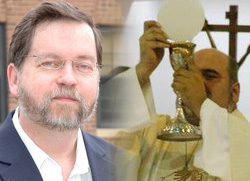The Essence of Crackers
For some reason, I’ve been thinking recently about the eucharist. Specifically, how a piece of flavorless bread can be transformed into a piece of Jesus while still looking and tasting like a flavorless piece of bread. I’d like to think that this is because I try to be fair to theists, but it might also be that I have too much free time.
The best analogy I could come up with was when I bought my house: you could have watched it the whole time I was at the signing ceremony, with electron microscopes and whatnot, and you wouldn’t have seen the moment when “some guy’s house” became “my house”.
What happened, of course, is that by virtue of me signing the paperwork, the rules for interacting with that house changed. The seller and I — and the rest of society — have agreed that once the paperwork is signed, I am allowed to come and go as I please, knock down walls, and take furnishings out to the dump, things that would have been considered breaking and entering, vandalism, and theft before the signature.
It seemed reasonable to conclude that something similar goes on at mass: once the bread has been blessed by the priest, the rules for interacting with it change. By mutual agreement, the congregation treats the wafers like Jesus Pieces.
Then I realized that that’s just a long-winded way of saying that it’s symbolic, and all the Catholics who raised a fuss over Crackergate were quite adamant that that wasn’t the case.
Here’s what the Catholic Encyclopedia has to say (or at least part of it, since the Catholic Encyclopedia can never give a plain and simple answer to anything):
The study of the first problem, viz. whether or not the accidents of bread and wine continue their existence without their proper substance, must be based upon the clearly established truth of Transubstantiation, in consequence of which the entire substance of the bread and the entire substance of the wine are converted respectively into the Body and Blood of Christ in such a way that “only the appearances of bread and wine remain” (Council of Trent, Sess. XIII, can. ii: manentibus dumtaxat speciebus panis et vini).
As I understand it, this means that everything has an essence that makes it what it is. A dog remains a dog even if it loses a leg; an albino ape is still an ape; if you break the arm off of a statue, it remains a statue. What happens at mass is the reverse: instead of the thing changing and the essence remaining the same, the thing remains the same, but its essence, its what-it-is-ness, changes.
Which is all well and good, except that it’s also bullshit.
If you keep breaking pieces off of a marble statue, at some point it stops being a statue and becomes gravel. If you keep changing pieces in a Lego house, it can become a Lego spaceship. If you eat a hunk of cow muscle, its atoms get rearranged and become human liver and bone, as well as a pile of feces. Which brings us neatly back to theology.
The notion that a communion wafer has an essential what-it-is-ness separate from the atoms that constitute it and the way they’re arranged is of a piece with belief in souls that survive the death of the body, and the “it’s still just a fruit fly” argument against evolution. It may look on the surface as though things have a magical essence, but that’s an illusion. Just because we see it, doesn’t mean it’s there. In fact, our economy is based in large part on the notion that things can change from one thing to another — that pile of rocks can become a pile of iron which can become a Ford Taurus; that a fistful of acorns can become a dining table.
The closest thing I can think of to essentialism that isn’t bullshit is intellectual property law. If I draw a cartoon mouse with a round head and round ears, the Disney Corporation will be able to successfully argue in court that I’ve infringed on their copyrighted image of Mickey Mouse®. In effect, they’ll argue that the essence of my picture is something that belongs to them. But even there, if I make enough changes, my picture will stop being Mickey Mouse.
I haven’t looked into it, but I imagine that while essentialism is an illusion, it’s a practical one. It’s useful to put men with beards in the same mental category as men in general, and to think that if a person loses a leg they don’t automatically stop being a person. So it’s a useful heuristic (a heuristic being defined as a rule that gives you something close to the right answer most of the time, but much more quickly that solving the problem properly).
Wafer-to-Jesus transformation clearly falls outside of the realm where the illusion of essence is useful or true. It’s time for theologians to stop twisting themselves into pretzels to pretend that it has any correspondence to reality.
Update, May 5, 2010: Inserted a missing “instead”. Oops.
